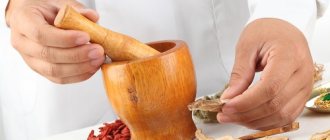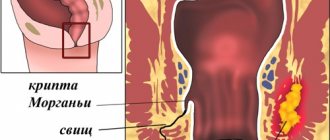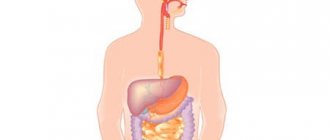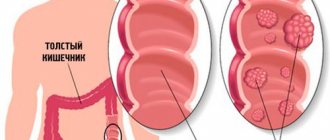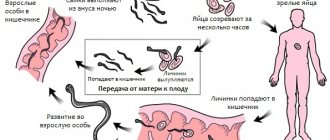Pinworms do not settle in the human body forever. Their lifespan is short, however, during this time they are able to reproduce a large number of eggs, from which no less dangerous parasites will appear in the future. In the case of severe infestation, there is a constant change of generations of these helminths, and people often do not know how long pinworms live.
How does the parasite work?
The appearance is unremarkable: light body color, small size (up to 13 mm). The pinworm belongs to the class of round parasites (a group of thin worms). Females and males differ somewhat in structure: in the former the body is pointed on one side, in the latter it twists like a snail. In addition, the sizes differ: the female is twice as long as the male in both length and width.
For attachment, parasites use a vesicle - it is located on the front of the body and is a small swelling. The parasite egg is also unremarkable from the outside: light in color, oval in shape and microscopic in size. On one side it is flattened. The offspring at this stage of development are not exposed to many external factors, but the protective shell dissolves in the intestines, which contributes to the appearance of small larval worms. The duration of their formation until sexually mature parasites is 2-4 weeks.
After emerging from the eggs, the larvae move to different parts of the intestine: the lower small intestine, the upper large intestine, and move towards the cecum. With enterobiasis (helminthic infestation by pinworms), the female leaves eggs on the outer integument of the human body, or more precisely, in the folds of skin near the anus.
Life cycle of helminth
To effectively combat worms of this form, you need to know how long pinworms usually live outside the human body, how long they live in the intestines and what is the life expectancy of such parasites at the initial stage of formation, i.e. in the egg. This will allow you to choose the right treatment regimen. It is not without reason that most doctors recommend repeat therapy some time after the main course. Thanks to this feature, it is possible to destroy the young offspring of helminths, which appear from eggs previously laid by the female.
The offspring penetrates the human digestive system as a result of re-infection of the body: while scratching the anus due to persistent itching, the person then carries eggs into the oral cavity on the fingers and nails. As a result, the neoplasms are sent directly to the intestine (small section), where larvae appear and move into the large intestine.
As they move locally, 2 molts are observed, which result in adult worms. The development cycle of pinworm parasites is short. It will take about 1 month from the moment the eggs appear until the formation of sexually mature individuals.
Lifespan of an egg-shaped pinworm outside
The offspring of parasites initially appear on human skin. Considering that, along with the eggs, the female secretes a special substance that provokes severe itching in humans, there is a high probability of their spreading into the environment through the fingers, more often the nail plates. The main task of pinworms is to enter the digestive system of the host, however, part of the oviposition ends up on other surfaces that a person touches. The offspring can number up to 20,000 eggs; on average, the female lays up to 13,000 eggs. The period of maturation of the larvae inside the protective shell is up to 6 hours.
In the environment outside the human body, pinworm eggs are viable for up to 3 weeks
The offspring can live outside the human body for up to 3 weeks, which is determined by environmental conditions. So, the warmer it is, the rapidly the life expectancy of pinworms decreases. The main condition for this is a sufficient level of humidity. The drier the air, the faster the eggs die. At low temperatures, helminths are also able to survive. For example, at a value of -8 degrees, the offspring remain viable for another 18 hours.
Lifespan of pinworms inside the human body
Adults are capable of living only within the body of their host. Life expectancy 1-2 months. During this period, helminths actively parasitize humans. After the mating process, the males die. The task of females is to lay offspring. After this, the female also dies.
The life cycle of a female pinworm can be interrupted as a result of human scratching of the skin and even before laying. In the second case, the body of the parasite decomposes inside the intestine, however, the eggs are released. For this reason, the death of a female parasite inside the human body does not stop the development of helminthiasis.
Treatment of enterobiasis during lactation.
Since anti-pinworm drugs are contraindicated during lactation, in this case treatment can be carried out without the use of anti-pinworm drugs. You can place a cotton swab in the anus between bowel movements, preventing the parasites from crawling out for 40 days (the maximum lifespan of pinworms). If you are very worried about itching in the rectum, it is recommended in the evening (during the maximum accumulation of pinworms) to do an enema to wash them out. At the same time, hygiene measures are taken to prevent re-infection. However, such treatment methods are not practical and have not been used for a long time; moreover, they can worsen the course of hemorrhoids (if the patient suffers from this disease).
You still have to use anti-pinworm treatment with interruption of breastfeeding for about four days (the preferred method).
How can you become infected with pinworms?
If a pinworm appears in the body, its life cycle begins when the eggs are swallowed, which are initially deposited in the folds around the anus. Further, the distribution pattern of parasites may change:
- They enter the oral cavity through the fingers.
- Much less often, part of the offspring enters the rectum through the anus.
The main and only source of infection is from person to another person. Due to scratching of the anus and due to regular failure to comply with hygiene rules, a significant part of the eggs ends up on various surfaces, furniture, underwear, bed linen and other things.
This is the main cause of contamination of soil, water, food, toys, and equipment. Due to the contact of the infected person with various objects, the offspring of pinworms are transferred to other surfaces. Considering that they live up to 3 weeks in favorable conditions, anyone who comes into contact with the patient will be infected.
There are other sources of spread: air currents, they lift the lightest protective shells of eggs; pet hair. However, dogs living at home with an infected person cannot get this form of helminthiasis, but are carriers (on their fur). Sometimes the larvae hatch from eggs directly on the skin around the anus. At the same time, they strive to re-enter the human digestive system.
If one family member is infected, there is a very high chance that others will be infected as well. Thus, everyone needs treatment!
Incubation period for helminthic infestation with pinworms
Invasion occurs after a short period of time. It all depends on how good the living conditions are, as well as on the location of the parasites. So, if the eggs enter the human body, the incubation period lasts no more than 6 hours. After this period of time, the parasites become invasive. If the offspring remains outside the human body, the duration of the incubation period increases significantly: from 6 hours to 15 days.
Interesting video: Enterobiasis - signs and symptoms
Stage 5 – larval formation and reinfection
At high humidity and a temperature of 35-36⁰C, the duration of maturation of laid eggs is up to 4-6 hours. If personal hygiene rules are not followed, larvae appear from them, which penetrate back into the rectum and large intestine. When eggs are introduced into the oral cavity, reinvasion occurs - the life cycle of the pinworm is repeated.
The duration of the entire development of the helminth from ingestion of eggs to the death of adult individuals is up to 1 month. Severe helminthic infestation drags on for several months, causing serious intoxication of the body. The risk of helminth infection persists for 2-3 weeks - this is the answer to the question of how long pinworm eggs live in the environment.
On a note!
Most of the live and killed adults and eggs leave the body of an infected person in the feces. Their detection in feces serves as the main method for diagnosing enterobiasis.
Dangers of enterobiasis
Considering the peculiarities of the life cycle of pinworms, it is important to carry out treatment repeatedly: twice or thrice, after a certain period of time. This allows you to destroy helminths that have reappeared from recently laid eggs. If you ignore this recommendation or do not eliminate the cause of unpleasant symptoms in time, more serious consequences will appear over time:
- Poisoning of the body with toxic products from the vital activity of parasites.
- Allergic reactions due to the presence of harmful substances.
- Disruption of the digestive system.
- Inflammation of the cecum, which will eventually cause appendicitis.
- Microflora and intestinal motility are disrupted.
- The immune system weakens.
- The risk of penetration into the female genital organs, which is the cause of various inflammatory diseases.
Clinical picture of enterobiasis.
Pinworms are the causative agent of enterobiasis. As a result of the mechanical and allergic actions of parasites, in addition to one of the leading symptoms - itching in the perianal area, abdominal pain, loss of appetite, and headaches appear. Sometimes pinworms crawl into the female genital tract, causing inflammation. Parasitism by pinworms leads to the development of dysbiosis, i.e. disruption of the normal intestinal microflora, which in turn increases the risk of developing intestinal dysfunctions and infections.
Children with enterobiasis are much more likely to have traces of fecal contamination on their hands compared to healthy children, which also contributes to the more frequent occurrence of intestinal infections and hymenolepiasis.
The causative agent of enterobiasis
The pinworm is a nematode of white color, small in size, the female reaches 5 mm, the male 12 mm.
The male has a curled end, the female has a pointed end. A vesicle is visible in front - the oral part of the parasite, with the help of which the pinworm is attached to the walls of the body
The vital activity of the parasite is carried out due to the contents of the intestine; the main component of the diet is beneficial human bacteria. They can also feed on blood. As a result, sick people experience indigestion and diarrhea.
The laid egg of the parasite contains a not quite mature larva. Final ripening occurs within 4–5 hours, reaching adult size in a month.
Then the ripening cycle repeats again. In this case, favorable conditions are necessary, a certain human body temperature of not lower than 36.5 degrees, increased humidity up to 70% - 100% (the optimal place is the human perineum).
Complications of enterobiasis.
Complications of enterobiasis can be:
- Eosinophilic enterocolitis (intestinal damage), caused by the body's high sensitivity to pinworm antigens, or prolonged infection.
- Vulvovaginitis (inflammation of the vagina and external genitalia) and urinary tract infections caused by pinworms crawling into the genitals of little girls.
- Salpingitis or oophoritis develops as a result of the penetration of pinworms into the pelvic organs.
- Appendicitis, which is a consequence of pinworms entering the cecum.
- Peritonitis caused by the passage of pinworms through the intestinal wall into the abdominal cavity.
Life cycle of pinworms
The life cycle of a pinworm is not long. The individual lays eggs with an embryo, which transforms into a larva within 5 hours. In a favorable environment, eggs live for about one month. Infection occurs through contact with a sick person or close contact with things or utensils of an infected person.
The larvae penetrate and hatch in the small intestine, then move into the large intestine.
After two weeks, the larva becomes an adult, capable of laying eggs on its own, but it retains them in its body, gradually migrating down the large intestine.
During the night's rest, the female exits through the anus and lays up to 20 thousand eggs around the anus. The development cycle of pinworms in the body does not exceed one month. The male dies immediately after fertilization of the female.
- after laying eggs, the patient can crush the individual while scratching;
- dies even before the laying of eggs begins, but after the decomposition of the helminth, the larvae are released and begin their life activities.
For the infected person, frequent diarrhea is not so much a discomfort as irritability and itching in the anal area. Since helminths more often emerge and lay eggs at night, a person’s sleep may be disturbed, fatigue may develop, the nervous system may experience nervousness and unpredictable aggression towards others.
With the loss of nutrients in the body, people noticeably lose weight, and the level of hemoglobin in the blood drops sharply.
Children, due to their age, do not understand what is happening to them; they can scratch the itchy area, thereby ending up with eggs on their hands or under their nails. In girls, eggs often enter the vagina and cause inflammation - vulvovaginitis. The girl is taken to a female doctor, while the cause of the disease itself often remains unknown.
The patient becomes a carrier of helminths by touching toys, things, and dishes with infected hands. Then the parasite quietly emigrates back into the body through dirty hands and the pinworm development cycle repeats.
Important! It is known that if hygiene is observed, helminths die in the body and come out within three months!
The life cycle of this parasite is quite simple, it reproduces only in a living organism, and does not even require another host. The infected person himself may be the sole or intermediate carrier of helminths.
Human pinworm
The main location of this type of helminth is the human large intestine. But in order for an egg to become infectious, it must be outside the host’s body and there must be oxygen present. The structure of a roundworm is no different from the structure of other roundworms.
The body of the helminth looks like a spindle. It has a white color. In females, one end is pointed; in males, the back of the body is curved and resembles a hook. Their size varies from three to twelve millimeters, depending on the sex of the individual.
A peculiar parasitism of helminths provokes symptoms of irritation and inflammation of the mucous wall of the large intestine. There is an opinion that they are involved in the occurrence of the inflammatory process that occurs in the vermiform appendix of the cecum. According to statistics, when performing about fifty percent of appendectomies in the cecum, specialists observed the presence of pinworms. There have been no cases of life-threatening cases caused by the presence of this type of helminth in the body.
The nutrient medium for nematodes is the contents of the intestine, and they also feed on intestinal bacteria. This fact has been established as a result of ongoing research. When, in the presence of enterobiasis, a patient was simultaneously diagnosed with bacterial pathologies, a course of antibacterial therapy was prescribed, which had a detrimental effect on pathogenic bacteria, but in the end the nematodes also died. Therefore, scientists have come to the conclusion that the main food for such parasites is intestinal bacteria.
The human pinworm cycle takes little time. In the eggs laid by the female roundworm, the larva develops after about five to six hours. Once in the soil, they remain viable for 21 days. Human infection occurs orally by ingesting eggs or through the skin. The larvae are released from the shell in the area of the small intestine and rush to the upper part of the large intestine to mature. Nematodes become sexually mature after two weeks.
After mating with a male, the female produces eggs and stores them in her body. During this period of life, she does not release them outside. Begins to move towards the rectum. In this case, a person may experience minor discomfort from the digestive system. The most unpleasant and painful sign of the vital activity of the parasite for a person during this period is unbearable itching in the anal area.
Having reached the rectum, female helminths crawl out through the anus at night. From the outside, they begin laying infected material on the skin of the perianal area and buttocks. The fertility of females is high and can amount to up to 25 thousand eggs. After laying eggs, the female dies. Parasites live in a human systemic organ for about thirty days.
Treatment of pinworms in adults. Read about the treatment of pinworms in children here.
Find out how to treat children for pinworms at home from the article:
Helminths emerging from the opening of the rectum to lay eggs provoke the development of itching and burning. Since females most often come out at night, a person experiences sleep disturbances. He becomes irritable and restless.
This infection most often occurs in children. Children scratch the anal area during sleep and thus collect worm larvae under their nails and on their hands. From contaminated hands, through food and household items, they enter the oral cavity of children. It is possible to ingest eggs containing dust particles.
On a note. Pathogenic round helminths, parasitizing the human body, undergo a simple life development cycle, which does not even require the presence of an intermediate host.
Nematodes, including pinworms, do not have a fixative function. They are retained in the intestines due to their active mobility and strong muscular system. Their survival is ensured by high fertility and ease of reinvasion of people.
Since infection with such worms can occur several times in a row, parts of the intestine may contain parasites at different stages of ontogenesis. To get rid of helminths, constant control measures are necessary, because their widespread prevalence leads to the risk of frequent infestation.
Detection of enterobiasis
Detecting the parasite is quite simple; you need to go through two stages.
The first stage involves a thorough interview:
- what is he complaining about?
- appearance of the first symptoms
- Does anyone in your immediate circle complain of similar symptoms?
- Is the rule of personal hygiene observed (constantly clean hands).
At the second stage:
- laboratory examination of stool is carried out;
- scrapings are taken near the anus using adhesive tape;
- examination of a general blood test from a finger (there are characteristic indicators of the presence of parasites).
The main indicator is a low level of hemoglobin, the normal level is 120 - 140 g/l, red blood cells - 3.5 - 5.3, with a low level anemia occurs. Anemia appears when the disease is advanced, with a large presence of parasites and during an inflammatory process in the body.
Inflammation of the genital organs, mainly in girls. Appendix - there is no reliable evidence that helminths entering it lead to inflammation of the appendix. The gallbladder is involved in the digestion process.
Active pinworms can move through the intestines not to the exit to the anus, but rather in the other direction to the anterior sections of the gastrointestinal tract. The bile ducts penetrate into the gallbladder itself and, irritating the mucous membrane of the wall, cause inflammation - cholecystitis.
Tests for pinworms
To detect parasites, laboratory tests are done:
- scraping for pinworm eggs;
- finger prick blood test;
- analysis of stool.
How are they carried out?
Scraping for pinworm eggs
The analysis is carried out in two ways:
- Using a cotton swab soaked in glycerin, a sample is taken from the skin in the anus and skin folds. The stick is placed in a test tube and subjected to laboratory diagnostics for the presence of pinworms;
- Using adhesive tape. It is pressed to the anus area, then transferred to the glass. The material is examined under a microscope to determine the presence of a parasite.
Blood test
The method helps determine the presence of foreign proteins in the blood, the presence of inflammation and changes in its chemical composition. The analysis is done in the morning on an empty stomach.
Treatment
All contacts, including family members without symptoms, must be treated for prevention. More often, adults do not feel any abnormalities in their health and have no signs of illness.
But it is still necessary to undergo examination and proper treatment. Otherwise, you can infect a re-cured family member. After all, if one person is a carrier of parasites, then the likelihood of infecting other members of society increases significantly.
We come to the conclusion that every carrier of helminthiasis needs treatment!
Deworming is the main method of treating enterobiasis with the help of medicinal drugs.
The most widely used drugs are:
- Vermox , white tablets 0.1 g. They have a paralyzing effect on the parasite. After ingestion, the helminths die and are excreted in the feces. Children from 3 to 10 years old are given 0.5 g of the drug. Adults are given 0.1 g of the drug. Doctors recommend treating the whole family at once, under the supervision of the attending infectious disease specialist or therapist.
- Medamin - tablets No. 10, penetrating orally into the body, paralyzes pinworms, which in turn cannot hold on to the mucous membrane and are expelled. A dose of 10 mg per 1 kg of body weight is applied once 3 times a day.
- Piperazine – tablets No. 0.2, 0.5g. It has a detrimental effect on the nerve impulse of the muscles, the parasites come out on their own.
During pregnancy
During pregnancy during the first three months, drug treatment is prohibited. It is necessary to limit ourselves to preventive measures.
If hygiene rules are followed, the helminths will die on their own. But if a doctor considers it appropriate to prescribe a drug, then Mebendazole, which he recommends, also does not have a license for use by pregnant women.
When breastfeeding, treatment with anthelmintic drugs is also prohibited. It is enough to limit yourself to compliance with preventive measures.
Products useful for enterobiasis
It is recommended to eat spicy and bitter foods. Walnuts, pumpkin seeds, flax seeds. Vegetable oils have a beneficial effect on irritation and inflammation of the intestinal walls. All sour berries, fruits and vegetables.
Preventive actions
- If enterobiasis is detected, immediately begin treatment to prevent infection of others;
- compliance with hygiene rules;
- regular change of underwear and outerwear;
- hot processing of raw food;
- do not hesitate to tell adults about the presence of itching in the anus.
After treatment, general cleaning is carried out using disinfectants, washing agents, and quartz coating of the room.
When an enterobiasis epidemic is detected, persons in contact with patients use anthelmintic drugs for prevention.
No one is safe from helminthic infestation. Children are most susceptible to infection. Children's pinworm is more common than others and provokes the development of enterobiasis. This is not the most severe form of invasion, however, if it is ignored, serious complications will develop.
With timely provision of medical care, the child will quickly get rid of uninvited guests.
What to do? To begin with, we recommend reading an article from the main institute of parasitology of the Russian Federation. This article reveals a method by which you can cleanse your body of parasites, without harm to the body. Read the article >>>
What it is?
What kind of parasite is this and what do pinworms look like? In fact, this is one of the varieties of worms, however, they are much smaller in size. The pinworm is a white worm . Males grow very tiny, no more than 5 mm. But females, as the main distributors of offspring, are much larger and can be up to 1.5 cm in length.
In the photo, pinworms look like small sticks with pointed ends. It is thanks to this feature that they received such a name. But eggs are small oval-shaped grains that will not be easy to notice at random.
The specific structure of the worm largely influences the manifestation of their presence. Symptoms of pinworm worms are primarily based on itching in the anus. It is much less common to accidentally detect them on the skin, underwear or in feces. You can see a more detailed description of pinworms on Wikipedia.
What is a baby pinworm?
Adult and child pinworms are the same parasite, which belongs to the group of roundworms. It is distinguished by a spindle-shaped shape, similar to a short thread (about 1.5 cm in length). Male pinworms are always smaller than females.
The worm received the name pinworm due to the structural features of the female’s body - its back part is slightly pointed, similar in appearance to a needle.
To prevent pinworm infestation of a child, parents should know the characteristics of this parasite - how it is transmitted, its life cycle and how it is treated.
Children are more likely than adults to become infected with pinworms. This is due to non-compliance with the rules of personal hygiene and contact with contaminated household items. The life cycle of pinworms is very simple, the only carrier is humans.
You can become infected from animals if there are eggs on their fur, and after contact with them the child does not wash his hands with soap.
There are three main ways of infection:
The structure of pinworms
Pinworms are parasitic roundworms of the nematode Enterobius vermicularis, which belong to the group of small worms. A distinctive feature of the parasites is the pointed tail end.
Female pinworms can reach 10 mm in length, while males measure no more than 5 mm. Unlike females, males have a pointed, spindle-shaped tail that curls into a snail-like shape. The body of the parasites is white with a grayish tint. Pinworms attach to the inner wall of the intestine through a small swelling on the front of the body called a vesicle.
Helminth eggs laid by females are oval in shape and have a colorless shell. On one side they are convex, and on the other they are flattened. When the membrane in the duodenum dissolves, the larvae are released and move to the lower part of the small intestine and the upper part of the large intestine. All this will be shown by a stool analysis for helminth eggs.
Pinworm development cycle:
- After the helminths enter the intestines and the larvae hatch, the life cycle of the pinworm begins. The larvae develop into adults within two to four weeks. The life span of pinworms in a mature state lasts no more than one month, after which the parasites die.
- Pinworms usually choose to parasitize the cecum, the upper part of the large intestine and the lower part of the small intestine. After fertilization, the females move into the rectum, emerge from the anus and lay eggs near the anus.
- Usually this process occurs at night, when a person is sleeping and the muscle tissue of the anal canal is in a relaxed state. At one time, worms can lay up to 13 thousand eggs, after which the pinworm completes its life cycle, dries out and turns into an amorphous mass.
- Parasite eggs mature in 4-6 hours. In order for them to remain viable, it is important at what temperature and humidity the eggs were laid. If the temperature in the perineum and perianal folds is below 34 degrees, the parasites may die.
Thus, the life cycle of a pinworm consists of eggs entering the intestines, transforming them into larvae, maturing adult parasites, laying new eggs by mature females, after which the whole process is repeated again.
Life cycle of pinworm
The female lays eggs around the anus, since this process is accompanied by itching, the baby regularly scratches this place. This is how the eggs get under the nails and they spread. Failure to comply with personal hygiene rules contributes to the proliferation of pinworms.
After swallowing pinworm eggs, they enter the intestines and degenerate into larvae, which in turn grow to mature individuals and reproduce. Males die after mating and are excreted along with feces. Worms feed on the contents of the intestines, as well as blood.
Several thousand helminths can simultaneously parasitize the human intestine. In just a month from the moment of mating, the female begins to lay eggs. To do this, it gets out of the intestines at night. One female can lay up to 20 thousand eggs, which take 6 hours to mature.
Life cycle of pinworm
Eggs get on underwear and bedding, under nails, spread throughout the house along with dust, and are found on household items and toys - this contributes to regular infection of a person.
Stage 4 – egg laying
To effectively treat enterobiasis, it is necessary to know how long pinworms live in the human body. Females, filled with eggs, break away from the intestinal wall and gradually move into the rectum. In search of a place to lay, they go outside. The most common areas for worm eggs to be deposited are:
- folds of the anus;
- gluteal folds, perineum;
- vaginal and genital area.
Important!
The number of eggs laid by one female averages from 13 to 20 thousand. Most often, this process occurs at night when the sphincter muscles are relaxed. After laying, female pinworms die, turning into an amorphous mass. The eggs are secreted with a special mucus that causes severe itching and burning in the anal area. When combed, they get under nails, bedding, and personal hygiene items.
Pinworms in humans
Children's pinworm eggs
What doctors say about treating parasites
Doctor of Medical Sciences, Professor German Shaevich Gandelman
Work experience: more than 30 years.
I have been detecting and treating parasites for many years. I can say with confidence that almost everyone is infected with parasites. It's just that most of them are extremely difficult to detect. They can be anywhere - in the blood, intestines, lungs, heart, brain.
Parasites literally devour you from the inside, at the same time poisoning your body. As a result, numerous health problems appear, shortening life by 15-25 years.
The main mistake is delaying! The sooner you start removing parasites, the better. If we talk about medications, then everything is problematic. Today there is only one truly effective anti-parasitic complex, this is TOXIMIN. It destroys and sweeps out all known parasites from the body - from the brain and heart to the liver and intestines. None of the drugs existing today is capable of this.
Within the framework of the Federal program, when submitting an application before June 10. (inclusive) every resident of the Russian Federation and the CIS can receive one package of TOXIMIN FOR FREE!
The eggs of the parasite are microscopic in size, so they can only be seen with the help of special equipment. Only adult individuals can be seen in feces. The eggs are slightly oblong, round in shape, asymmetrical with a double-contour shell. They are distinguished by a white, slightly grayish color.
Under favorable conditions (humidity about 70%, temperature 22-40 degrees) outside the human body, eggs can retain their vital functions for about a month.
Violation of any conditions leads to their death. Therefore, to prevent the parasite from multiplying, it is recommended to carefully iron linen and clothes.
Pinworm infection: symptoms and methods of diagnosing the disease
A specific symptom of enterobiasis is severe itching in the perianal area. It reaches its maximum intensity at night or immediately after waking up. Often, such manifestations that accompany pinworm infection lead to sleep disturbances, irritability and nervousness.
Because of this, the child’s performance at school may decrease, attention and ability to concentrate may deteriorate.
In addition, enterobiasis may be accompanied by the following clinical signs:
- Redness, swelling in the anal area, increased pain when touched.
- Unstable stool (constipation alternating with diarrhea).
- The presence of clots of mucus or blood in the stool.
- Flatulence.
- Bloating.
- Pain in the stomach area.
- Nausea and vomiting are more typical for children.
It is important
Parasites attach to the intestinal wall, causing microdamage to the mucous membrane.
Long-term infection with pinworms is accompanied by a general deterioration in health. Due to small but constant blood loss, a person often suffers from anemia (low hemoglobin levels in the blood). The vital processes of parasites are accompanied by the release of toxic products that enter the systemic bloodstream through the intestinal wall. First of all, the nervous system suffers from this; the patient complains of general malaise.
Damage to the epithelium of the gastrointestinal tract leads to disturbances in the absorption of vitamins and other nutrients. Therefore, without appropriate treatment, pinworm infection causes the classic symptoms of vitamin deficiency: brittle nails, hair loss, dry skin, frequent persistent viral and bacterial infections.
Diagnosis of enterobiasis
If the patient consults a doctor with the corresponding symptoms, the doctor collects a detailed medical history and finds out possible routes of transmission of parasites. But before prescribing treatment, they are sent for a general clinical blood test and scraping for enterobiasis. Pinworm infection occurs with a decrease in hemoglobin levels (below 130 g/l in men, less than 120 g/l in women and up to 100-110 g/l in children). Parasites often cause an allergic reaction, so when reading a blood test, an increase in the number of eosinophils (more than 5) is detected.
A scraping for enterobiasis can reveal pinworm eggs. To carry out the analysis, a glass slide and a small piece of tape are enough. The technique for taking the material is simple: you need to spread the buttocks and firmly apply the tape to the skin around the anus. Then glue it onto a glass slide.
It is important
A scraping for enterobiasis is taken immediately after waking up before visiting the toilet and performing hygiene procedures.
The disadvantage of this test is the high risk of a false negative result. Pinworms do not lay eggs all the time. Therefore, if there are characteristic symptoms and a negative scraping, it is recommended to repeat it several times with an interval of 3 to 5 days.
Routes of infection
The main methods of infection include:
- scratching the anus - eggs get under the nails, underwear and subsequently spread throughout the house;
- contact with an infected person due to non-compliance with hygiene standards;
- ingestion of eggs on bedding, dust;
- contact with contaminated household items, dishes, personal hygiene products, toys;
- consumption of dirty, uncooked food;
- insects can carry parasite eggs on their paws;
- contact with animals that had eggs on their fur.
If a child regularly bites his nails, puts dirty toys or hands into his mouth, or does not follow hygiene rules, the risk of developing an infection increases significantly.
Causes of infection
The pattern of pinworm infection involves the transmission of parasites from an infected person or from an infected animal to a healthy person. When infected, the patient experiences severe itching in the anus. When scratching the anus, pinworm eggs get under the nails.
If you do not follow basic hygiene rules, the infection enters the body through the nails and ends up in the intestines, where a new life cycle of helminths begins. An infected person can transmit the disease through contact with healthy people. Sometimes the development of eggs occurs in the fur of pets, so after handling pets you should always wash your hands with soap.
Thus, the main causes of pinworm infection are associated with non-compliance with hygiene rules. The infection can be brought from a kindergarten or school, where hygiene rules are not always followed; as a result, not only children, but also teachers or parents become infected.
Parasite eggs can end up not only under nails, but also on things that a person has come into contact with. Helminths can enter the body through dusty air, unwashed hands, or poorly washed foods. Also, cockroaches, flies and other insects often become carriers of infection, leaving eggs from their paws on open food.
If a person has the bad habit of biting his nails, there is a high risk of re-infection with helminths, even if treatment has already been carried out. In this case, prevention of enterobiasis is extremely important.
To avoid this, you need to wean yourself from the bad habit, cut your nails short, keep your hands clean and wash yourself with soap at least twice a day.
Symptoms
Tips from our readers
I got rid of parasites in just a week! I was helped by a remedy that I learned about from an interview with a parasitologist.
The development of the parasite is accompanied by a number of negative symptoms. The main one is severe itching of the perineum, which intensifies at night. Combing the masonry not only spreads the parasite, but also damages the skin, which causes inflammation.
| Secondary symptoms | Associated symptoms | Symptoms of the chronic stage |
|
|
|
In any case, the child experiences a significant deterioration in health, body temperature rises, and pain in the intestines develops. Scratching the anus leads to inflammation and the development of pathogenic bacteria.
Pinworm treatment
If tests confirm helminthic infestation, it is necessary to immediately begin treatment for pinworms in children and adults. Currently, various chemicals are used to destroy worms and speed up their evacuation. Unfortunately, such treatment of pinworms in adults does not always turn out to be quite effective: highly toxic drugs can have serious side effects, and the impossibility of taking them in long courses practically negates the chances of removing not only adult parasites from the body, but also their larvae and eggs. Therefore, after such ill-conceived treatment, the symptoms of pinworms in adults may return. This means re-infection has occurred.
How to remove pinworms from adults? Experts recommend choosing a drug that can be taken in long courses, guaranteeing complete relief from the invasion. It is also advisable to carry out simultaneous work to increase immunity and intoxicate the body.
Treatment of childhood pinworm
Treatment of enterobiasis in a child should be carried out under the strict supervision of the attending physician. Effective therapy requires an integrated approach, which includes:
- anthelmintics;
- sedatives;
- vitamin complexes;
- sorbents;
- immunostimulants;
- sometimes folk recipes.
An integrated approach allows you to speed up the process of recovery and restoration of the body after an infection. To avoid relapse, it is necessary to adhere to preventive rules and undergo re-treatment 2 weeks after the first.
The best anthelmintics:
| Drug name | Description |
| Piperazine | It has a mild effect on the body. Reception is carried out in a course of 5 days. For maximum effectiveness, you must complete at least 2 courses of treatment. |
To prevent relapse, you need to undergo repeated treatment and follow preventive measures:
- From an early age, teach your child to observe the rules of personal hygiene;
- wean your baby from putting dirty objects and hands in his mouth;
- cut your nails on time;
- wash the child twice a day;
- carry out wet cleaning of the premises;
- wash clothes and linen at the highest possible temperatures, followed by ironing;
- give the child only boiled water;
- All products must be thoroughly washed (ideally it is better to treat them with boiling water) and heat treated.
Although pinworm infestation is not the most dangerous form of infection, it is, however, accompanied by various negative symptoms that seriously affect the baby’s health.
Maintaining good hygiene standards significantly reduces the risk of infection. It is better to prevent the development of a disease than to treat it.
Symptoms of enterobiasis in children and adults
Pinworms usually do not cause acute pain. But unpleasant and painful itching in the anal area is noted by almost all infected people. Especially at night, which, of course, leads to sleep disturbances. The child and adult scratches itchy areas, contaminating their hands and especially the area under the nails, and then scatters thousands of eggs around themselves, touching the bed, dishes, toys, other people's clothes, food and everything that is within its reach. For this reason, the popular name for enterobiasis is “dirty hands disease .
That is why it is so difficult not to become infected with enterobiasis if these worms are found in at least one of your family members or someone in your immediate circle. If people are not accustomed to observe the rules of personal hygiene, we can say with almost 100% confidence that enterobiasis is present in all family members.
Symptoms of pinworms in children
In addition to the most characteristic symptom of pinworm infection – itching in the anal area, other signs of the disease are:
- problems with falling asleep in a child, restless sleep (fidgeting in sleep, screaming or crying in very young children, frequent awakening);
- poor appetite and nausea;
- and, conversely, increased appetite and profuse salivation;
- pain around the navel;
- problems with stool: diarrhea, constipation, dysbacteriosis;
- fatigue, irritability, causeless moodiness;
- may feel dizzy;
- possible headache;
- blue circles under the eyes and pale facial skin;
- grinding teeth in sleep.
For girls, the listed symptoms include urinary incontinence (enuresis) due to irritation of the urethra by pinworms, as well as the appearance of copious discharge from the genitals due to the penetration of these nematodes into them.
Advanced enterobiasis can provoke eczema, dermatitis, decreased hemoglobin levels, exacerbation of appendicitis, and peritonitis. In girls - vulvovaginitis and salpingitis. For boys, pinworms can also cause harm by introducing pathogenic microorganisms into the foreskin sac.
Symptoms of enterobiasis in adults
With a small number of nematodes in the body, a person may experience minor discomfort, which he usually does not pay attention to, or may not feel anything at all. If there is even the slightest suspicion of the presence of “uninvited guests,” you can deprive the females of the opportunity to reproduce, and, therefore, to re-infect themselves by following simple rules:
- maintain intimate hygiene daily,
- change underwear twice a day,
- Wash your hands thoroughly with soap after using the toilet and before eating.
Moreover, if you simply rinse your hands with water without soap, consider that you are not washing your hands at all. Only soap can bind oil and dirt on the skin of the hands and remove them. Washing your hands with water without soap leaves the oil and dirt on your hands untouched.
These simple hygiene rules will help cure enterobiasis in the initial stages without the use of drugs. However, in this case, you should not have anyone around you who is infected with pinworms.
If the infestation is severe and there are people with enterobiasis in your environment, the symptoms become vivid and the most pronounced of them is severe itching in the anus, which intensifies in the evening, at night or in the early morning. It is provoked by female nematodes that come out to lay eggs. This itching can torment a person for only one or two days, but will recur after two to three weeks - during this time there is a change in the generation of pinworms and re-infection.
In addition to itching, there are other symptoms and signs of the presence of pinworms:
- frequent urge to have bowel movements,
- stool up to four times a day,
- diarrhea or constipation,
- the appearance of blood or mucus in the stool,
- pain in the lower abdomen,
- in severe stages of the disease, pain in the abdomen on the right, similar to pain with appendicitis,
- nausea,
- bloating, increased gas formation in the intestines,
- dysbacteriosis,
- increased number of leukocytes in the blood.
If enterobiasis is not treated, in addition to allergies, intoxication and excessive irritability, problems with falling asleep and insomnia, dizziness, headaches, eczema and exacerbation of appendicitis may occur. For women, advanced enterobiasis is dangerous due to the appearance of diseases such as vulvovaginitis and endometritis due to the penetration of nematodes into the genital tract.
